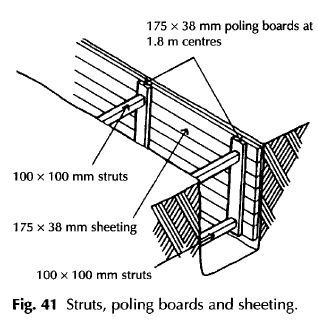The trenches which have to be dug for the foundations of walls may be excavated by hand for single small buildings but where, for example, several houses are being built at the same time it is often economical to use mechanical trench diggers.
If the trenches are of any depth it may be necessary to fix temporary timber supports to stop the sides of the trench from falling in. The nature of the soil being excavated mainly determines the depth of trench for which timber supports to the sides should be used.
Soft granular {soils} readily crumble and the sides of trenches in such soil may have to be supported for the full depth of the trench. The sides of trenches in clay soil do not usually require support for some depth, say up to 1.5 m, particularly in dry weather. In rainy weather, if the bottom of the trench in clay soil gets filled with water, the water may wash out the clay from the sides at the bottom of the trench and the whole of the sides above may cave in.
The purpose of temporary timbering supports to trenches is to uphold the sides of the excavation as necessary to avoid collapse of the sides, which may endanger the lives of those working in the trench, and to avoid the wasteful labour of constantly clearing falling earth from the trench bottoms.
The material most used for temporary support for the sides of excavations for strip foundations is rough sawn timber. The timbers used are square section struts, across the width of the trench, supporting open poling boards, close poling boards and walings or poling boards and sheeting.
Whichever system of timbering is used there should be as few struts, that is horizontal members, fixed across the width of the trench as possible as these obstruct ease of working in the trench. Struts should be cut to fit tightly between poling or waling boards and secured in position so that they are not easily knocked out of place.
For excavations more than 1.5 m deep in compact clay soils it is generally sufficient to use a comparatively open timbering system as the sides of clay will not readily fall in unless very wet or supporting heavy nearby loads. A system of struts between poling boards spaced at about 1.8 m intervals as illustrated in Fig. 39 will usually suffice.

Where the soil is soft, such as soft clay or sand, it will be necessary to use more closely spaced poling boards to prevent the sides of the trench between the struts from falling in. To support the poling boards horizontal walings are strutted across the trench, as illustrated in Fig. 40.

For trenches in dry granular soil it may be necessary to use sheeting to the whole of the sides of trenches. Rough timber sheeting boards are fixed along the length and up the sides of the trench to which poling boards are strutted, as illustrated in Fig. 41.

The three basic arrangements of timber supports for trenches are indicative of some common system used and the sizes given are those that might be used.